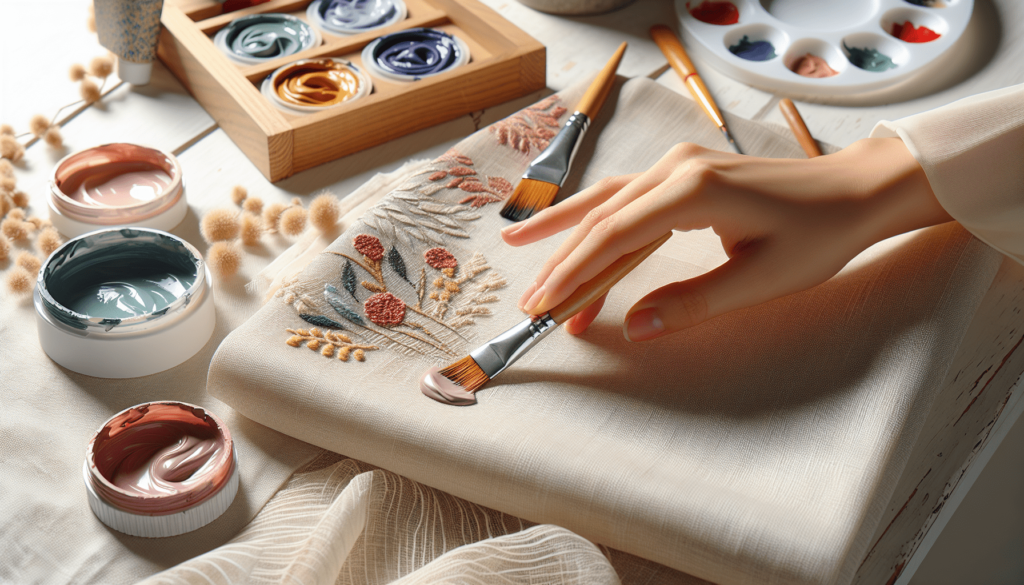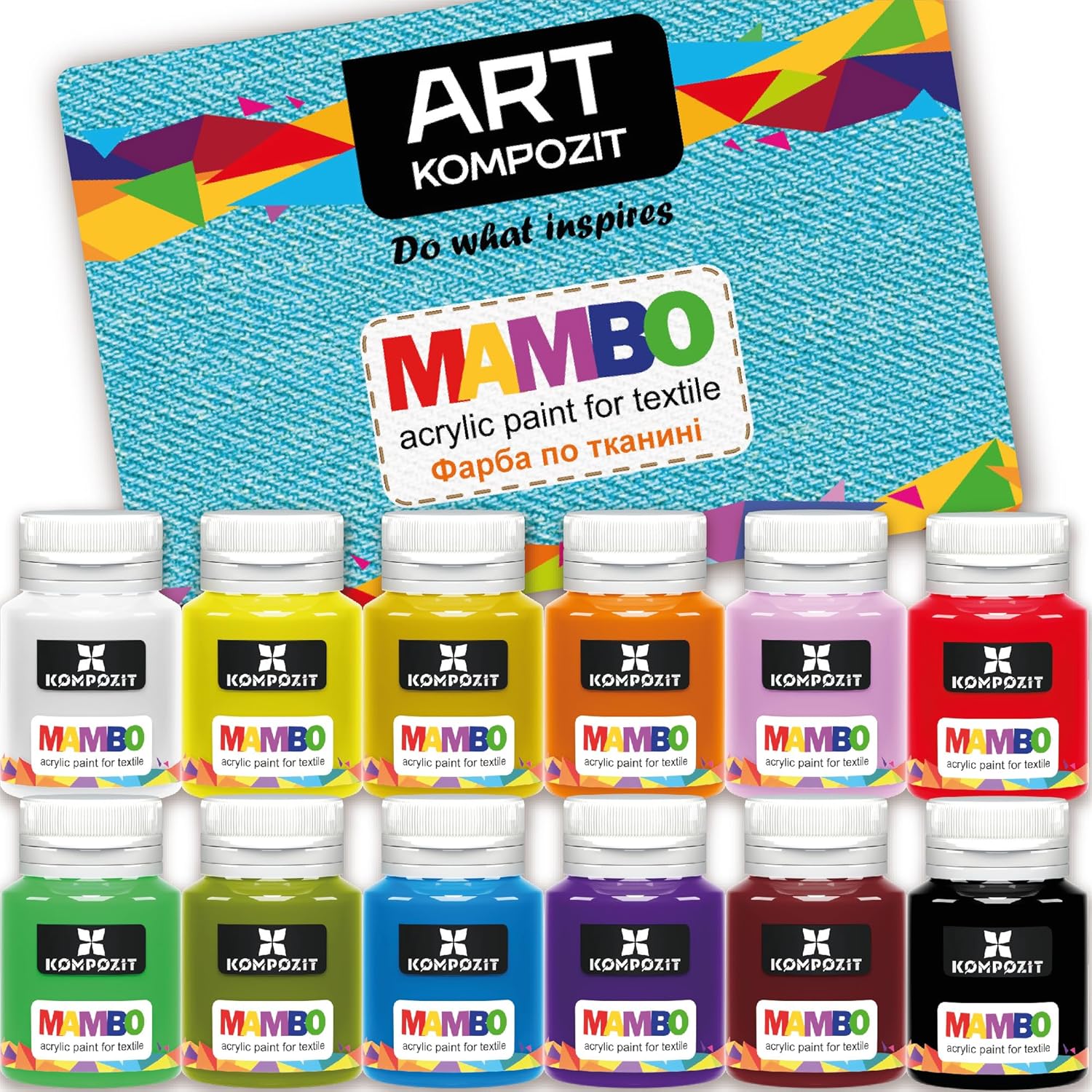Fabric paint is a versatile tool for adding creativity and personalization to your garments, but many wonder if it is compatible with polyester fabric. Polyester, known for its durability and wrinkle-resistance, can pose a challenge when it comes to adhering fabric paint. In this article, we will explore the effectiveness of fabric paint on polyester, offering insight into the techniques and considerations necessary to achieve successful results. Whether you’re a fashion enthusiast or simply looking to revamp your wardrobe, understanding the compatibility between fabric paint and polyester is essential to unleashing your artistic potential.
Introduction
What is fabric paint?
Fabric paint refers to a type of paint specifically formulated for use on various types of fabrics. It is designed to adhere to fabric surfaces and provide vibrant colors and designs that are long-lasting, even after multiple washes. Fabric paint comes in different forms such as liquid, spray, or pens, offering versatility for different application techniques.
What is polyester?
Polyester is a synthetic fabric that is widely used in the textile industry. It is known for its durability, wrinkle-resistant properties, and ability to retain vibrant colors. Polyester fabrics are commonly used in clothing, upholstery, and other applications where strength and stability are desired.
Why is this topic important?
Understanding the compatibility of fabric paint with polyester is crucial for individuals who are interested in creating personalized designs on polyester fabrics. With the increasing popularity of DIY projects and customizations, it is important to know how to effectively apply fabric paint on polyester to achieve desired results. This article will explore the properties of fabric paint and polyester, as well as provide insights into their compatibility and techniques for achieving successful outcomes.
Properties of Fabric Paint
Composition
Fabric paint is typically made up of pigments, binders, and additives. The pigments provide color, while the binders help the paint adhere to fabric fibers. Additives may be included to enhance properties such as flexibility, washability, and drying time. It is important to choose fabric paint specifically labeled for use on polyester to ensure compatibility and optimal results.
Application
Fabric paint can be applied to polyester using various techniques such as brushing, spraying, stenciling, block printing, or heat transfer. Each technique offers different levels of control and precision, allowing for a range of artistic possibilities. The application method chosen will depend on the desired design, personal preferences, and the tools available.
Drying time
The drying time of fabric paint varies depending on the specific product and application technique used. In general, fabric paint dries relatively quickly, allowing for efficient completion of projects. However, it is important to follow the manufacturer’s instructions regarding drying time and any recommended curing processes, as they can affect the overall durability and longevity of the painted design.
Durability
Fabric paint is designed to withstand various conditions, including repeated washing and wearing. However, the durability of fabric paint on polyester can be influenced by factors such as the quality of the fabric paint, the type of polyester used, the surface texture, and environmental conditions. Proper preparation, application, and curing techniques can help enhance the durability of fabric paint on polyester fabrics.

Characteristics of Polyester
What is polyester?
Polyester is a synthetic textile fiber derived from petroleum. It is known for its strength, resistance to stretching and shrinking, and ability to retain color vibrancy. Polyester fabrics are commonly used in clothing, home furnishings, and industrial applications due to their durability and versatility.
Advantages of polyester
Polyester offers several advantages as a fabric for painting. It has excellent color retention properties, allowing the painted design to remain vibrant even after repeated washes. Polyester is also resistant to wrinkling, making it a suitable choice for applications where durability and long-lasting designs are desired. Additionally, polyester fabrics are relatively easy to clean and maintain, adding to their practicality.
Challenges of painting on polyester
While polyester offers many benefits, there are certain challenges when it comes to painting on this fabric. Polyester is a synthetic material, and its smooth texture can make it more difficult for paint to adhere effectively. Additionally, the heat-resistant properties of polyester can sometimes make it challenging to achieve proper curing of fabric paint, leading to potential issues with durability and colorfastness.
Compatibility of Fabric Paint with Polyester
Adhesion
Ensuring proper adhesion of fabric paint to polyester is crucial for achieving long-lasting designs. Fabric paints specifically formulated for use on polyester are designed to adhere to the fabric fibers, providing a strong bond that resists peeling or fading over time. It is important to choose fabric paints that are labeled as suitable for use on polyester to ensure optimal adhesion and durability.
Color intensity
One of the key considerations when using fabric paint on polyester is the desired color intensity. Polyester fabrics have the ability to retain color vibrancy, but certain fabric paints may provide more intense and vibrant colors than others. It is advisable to test the fabric paint on a small, inconspicuous area of the fabric before beginning the project to ensure that the desired color intensity is achieved.
Flexibility
Polyester fabrics are known for their strength and resistance to stretching, making them suitable for various applications. The flexibility of fabric paint is an important factor to consider when painting on polyester, as it should allow the design to move and flex with the fabric without cracking or peeling. Choosing fabric paints that offer flexibility and elasticity can help ensure the longevity of the painted design.
Washability
Polyester fabrics are often subjected to frequent washing, requiring fabric paint to withstand the rigors of laundering. Fabric paints formulated for use on polyester are typically designed to be washable, allowing the painted designs to remain intact even after multiple washes. It is essential to follow the manufacturer’s instructions regarding washing and care instructions to maintain the longevity of the painted polyester.

Preparation for Painting Polyester
Cleaning the fabric
Before painting polyester, it is important to ensure that the fabric is clean and free of any stains, dirt, or residues. Polyester fabrics should be washed according to the manufacturer’s instructions to remove any sizing agents or finishes that may hinder paint adhesion. Additionally, any stains or spots should be treated and removed prior to painting.
Priming the surface
Priming the surface of the polyester fabric can enhance paint adhesion and promote better color retention. A textile primer specifically formulated for use on polyester can create a suitable surface for the fabric paint to adhere to, preventing issues such as peeling or flaking. Primers can also help seal the fabric fibers, minimizing the risk of bleeding or spreading of the paint.
Testing on a small area
Before embarking on a large painting project, it is advisable to test the fabric paint on a small, inconspicuous area of the polyester fabric. This will allow you to assess the adhesion, color intensity, and overall compatibility of the fabric paint with the fabric. It is recommended to wait for the paint to fully dry and conduct a wash test to ensure that the design remains intact.
Techniques for Applying Fabric Paint on Polyester
Brushing
Brushing is a versatile and commonly used technique for applying fabric paint on polyester. It allows for precise control and the ability to create detailed designs. Different types of brushes can be used, such as flat brushes for bold strokes or fine brushes for intricate details. When brushing fabric paint on polyester, it is important to apply thin, even layers and allow proper drying and curing time for optimal results.
Spraying
Spraying fabric paint on polyester offers a different approach, allowing for more even coverage and a smooth finish. Spray fabric paints are available in aerosol cans, providing an easy-to-use application method. When spraying fabric paint on polyester, it is important to follow the instructions on the can regarding distance, spraying technique, and drying time. This technique is ideal for creating gradients, backgrounds, or large-scale designs.
Stencil application
Using stencils can be a convenient method for achieving precise and repetitive designs on polyester. Stencils come in various shapes and patterns, allowing for a range of creativity. When applying fabric paint with a stencil, it is important to hold the stencil firmly in place to prevent smudging or bleeding of the paint. Careful removal of the stencil after painting and allowing sufficient drying time are crucial for clean and precise results.
Block printing
Block printing is a traditional technique that involves carving a design into a block and transferring it onto fabric using fabric paint. This technique can create bold, textured designs on polyester. When block printing on polyester, it is important to use suitable fabric paint designed for the specific technique to ensure optimal adhesion and durability. Applying even pressure during printing and allowing ample drying time are essential for achieving clear and crisp designs.
Heat transfer
Heat transfer is a popular technique for applying intricate designs or photographs onto polyester fabric. It involves printing or transferring a design onto a special heat-transfer paper and then using heat and pressure to transfer the design onto the fabric. This technique requires a heat press or an iron set to the appropriate temperature. Following the manufacturer’s instructions regarding heat settings and transfer times is crucial for achieving successful results when using heat transfer with fabric paint on polyester.
Factors Affecting the Success of Fabric Paint on Polyester
Quality of fabric paint
The quality of fabric paint used can significantly impact the success of painting on polyester. Choosing high-quality fabric paints specifically formulated for use on polyester can ensure better adhesion, color intensity, and durability. It is important to read product labels, user reviews, and recommendations from experienced artists to select reputable brands that have a proven track record of producing reliable fabric paints.
Type of polyester
Different types of polyester fabrics may have varying properties that can influence the compatibility and success of fabric paint. Factors such as the density, weave, and surface texture of the fabric can affect how well the paint adheres and how the colors appear. It is advisable to test fabric paint on a small area of the polyester fabric to assess compatibility before embarking on a larger project.
Surface texture
The texture of the polyester fabric can affect how the fabric paint adheres and appears after drying. Smooth textures may require additional priming or preparation techniques to enhance paint adhesion, while textured fabrics may require more careful paint application to ensure even coverage. Understanding the surface texture of the polyester fabric and adapting painting techniques accordingly can contribute to better results.
Environmental conditions
Environmental conditions such as temperature and humidity can impact the drying and curing process of fabric paint on polyester. It is recommended to paint in an environment with moderate temperature and humidity levels to promote optimal drying and curing. Extreme temperatures or high humidity can affect the paint’s ability to adhere and cure properly, potentially compromising the durability and longevity of the painted design.
Tips for Achieving Better Results
Mixing fabric paint
Mixing fabric paint colors can expand the range of possibilities and create unique shades and tones. It is important to follow the manufacturer’s instructions regarding color mixing, as different types of fabric paint may have varying guidelines. Starting with small amounts of paint and adding gradually can help achieve desired colors without wasting large quantities of paint. Keeping a record of color mixtures can also be helpful for future reference.
Layering and blending colors
Layering and blending fabric paint colors can add depth, dimension, and visual interest to designs on polyester. This technique involves applying multiple layers of paint in different colors, allowing each layer to dry before adding the next. Blending can be achieved by gently blending wet or partially dry layers together, creating smooth transitions between colors. Experimenting with different brushes, sponges, or blending tools can help achieve desired effects.
Proper drying and curing
Proper drying and curing of fabric paint is essential for achieving durable and long-lasting designs on polyester. Follow the manufacturer’s instructions regarding drying time, and ensure the painted fabric is completely dry before moving or wearing. Some fabric paints may require additional heat curing using an iron or a heat press to enhance adhesion, colorfastness, and washability. It is important to use the recommended heat settings and techniques to avoid damaging the fabric or the painted design.
Applying fixatives
Applying a fixative or textile medium to the painted polyester can help enhance the durability, washability, and color retention of the design. Fixatives are available in various forms and can be applied by spraying or brushing onto the painted fabric. It is important to use fixatives specifically formulated for fabric paint on polyester and follow the manufacturer’s instructions regarding application and drying time.
Testing the Painted Polyester
Washing and care instructions
To ensure the longevity of the painted design on polyester, it is important to follow the washing and care instructions provided by the fabric paint manufacturer. These instructions may include specific temperature ranges, washing cycles, and recommended detergent types. It is also advisable to avoid using bleach or harsh chemicals that may damage the painted fabric.
Colorfastness
Colorfastness refers to the ability of fabric paint to retain color intensity and resist fading or bleeding when exposed to washing, light, or other external factors. To test colorfastness, it is recommended to wash the painted polyester fabric according to the manufacturer’s instructions and observe any changes in color or bleeding. Colorfast fabric paints should retain their vibrancy even after repeated washes.
Abrasion resistance
Polyester fabrics can be subjected to abrasion through regular use and friction. Testing the painted polyester fabric for abrasion resistance involves rubbing or scrubbing the painted area with a cloth or abrasive material to assess any signs of flaking, peeling, or fading. High-quality fabric paints and proper curing techniques can enhance the abrasion resistance of the painted design.
Stretch and recovery
Polyester fabrics are known for their ability to retain shape and resist stretching. Testing the painted polyester fabric for stretch and recovery involves gently stretching the fabric and observing if the painted design maintains its integrity. A well-adhered and properly cured fabric paint should not crack or peel when subjected to stretching or pulling.
Conclusion
Summary of findings
Fabric paint can indeed work on polyester when certain considerations and techniques are applied. Understanding the properties of fabric paint and polyester, as well as their compatibility, is crucial for achieving successful and durable painted designs. Adhesion, color intensity, flexibility, and washability are key factors to consider when using fabric paint on polyester. Proper preparation, application techniques, and drying/curing processes can enhance the results significantly.
Recommendations
Based on the findings, it is recommended to choose fabric paints specifically labeled for use on polyester. Testing the fabric paint on a small area of the polyester fabric before proceeding with a larger project can help assess compatibility and achieve desired results. Following proper cleaning, priming, and drying techniques can enhance paint adhesion. Various application techniques such as brushing, spraying, stenciling, block printing, or heat transfer can be utilized based on personal preferences and desired designs. Additionally, applying fixatives and following washing and care instructions provided by the fabric paint manufacturer can help maintain the longevity and vibrancy of the painted polyester.
Final thoughts
Experimenting with fabric paint on polyester can be an exciting and creative journey. By understanding the properties of fabric paint and the characteristics of polyester, individuals can unlock a world of artistic possibilities. Through proper preparation, application techniques, and adherence to recommended drying and curing processes, one can achieve stunning and durable designs on polyester fabrics. With the right knowledge, tools, and techniques, fabric paint can indeed work effectively on polyester, allowing individuals to personalize their clothing, home decor, and other polyester-based projects.



